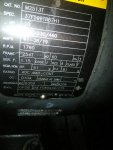moon -
First: kb hit it right on. Do not install a soft start or VFD until you
KNOW you will have sufficient torque to start the compressor. As you said, 'It’s a big load/inertia at startup, which needs to be overcome."
The LRC you quoted meets spec for a Code J. The motor is performing as it should. Consider: Small conductors going to the motor will not increase the LRC. Installing larger conductors to the motor will not lower the LRC. Either way - doesn't matter, the conductor size is not the cause of the voltage sags that are dropping out the LVP controllers - unless the LVPs are out at the end of the motor feeder. (Q: What is LVP? Low Voltage Protected? As in drop out at a pre-set low voltage?)
The generator is not too small. We don't know the distribution voltage. 316A, .8pf,
208V --> 90KW
240V --> 105KW
480V --> 210KW
any of those is big enough to adequately start a 15hp motor.
Considering the evidence you have given us, the problem is a distribution issue. The motor LRC is bringing the problem to light - but it is not the villian. Forget the motor for a bit. It is just another load.
The original question was about preventing voltage sag at the LVP scontrollers. Lets take a look at the distribution path.
Is the generation at 480V , 240V, or 208V?
Is the shore power input at 480V, ... ?
What I'm looking for here is:
Is there a transformer between the source and the motor.
Is there a transformer between the source and the LVP loads?
You will need to sketch out a one-line diagram. Start with the generator, to panelboards, to transformers, to loads.
You are looking for the place where the feed to motors splits off from the feed to the LVP starters - cause the voltage drop is upstream from there.
If I were guessing, I'd say the distribution was designed and in place long before 1998. The compressors were upgraded (bigger motors, biggers compressors) - but the distribution was not.
Get a one-line. Draw it your-self. That is the first step in troubleshooting exactly where the voltage drop is occuring.
Notes on the motor (mostly wild guesses):
The existing motor is an oddball - design A, code J. It doesn't have any better starting torque than a design B, but the LRC is undefined and often high - as you can see by the code J Locked Rotor KVA. Generally Design A is picked to trade off higher starting current for higher efficiency and low slip. (reference Nema MG-1). You might call the compressor mfg and ask them, "Why". But I doubt after 17 years anyone will know.
If I really had to drop the LRC, I'd consider new Design B, Code G motors. That will definitely drop the LRC and won't compromise the starting torque. DONOT get energy efficient - that just jacks up the LRC.
You might do it with a VFD. It can be programmed to hold up the starting torque. However, there are a new set of issues for designing a high starting torque vfd application:
It won't be done with a two-bit 15hp generic vfd. It will be one capable of 175% - 225% FLA for the starting duration.
Good luck - I'll be interested in what you find.
the Worm

